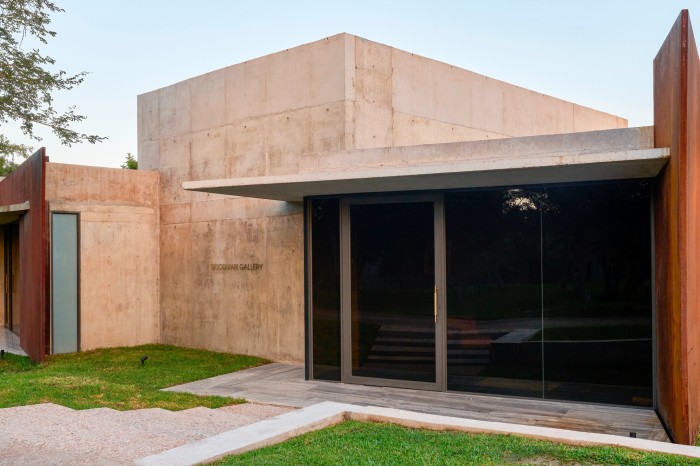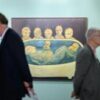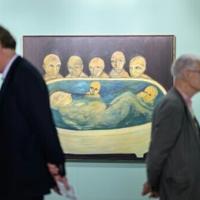Unlock the Editor’s Digest for free
Roula Khalaf, Editor of the FT, selects her favourite stories in this weekly newsletter.
Christie’s had the better results in this season’s Modern and contemporary evening auctions in London, posting an overall £163.3mn (£196.7mn with fees) on March 7, while the previous evening Sotheby’s made £82.2mn (£99.7mn with fees). Christie’s total, up 17 per cent on last year, was boosted by 25 Surrealist works, which included the week’s top lot, René Magritte’s late “L’ami intime” (1958), hammering to little fanfare for £29mn (£33.7mn with fees, estimate without fees £30mn-£50mn). The work was sold from the collection of the late publisher and conductor Gilbert Kaplan and his widow, who had bought the work for £90,000 at auction in 1980.
Overall results suggest there is still a disconnect between auction-house estimates and final prices in the more cautious environment. Totals at Sotheby’s and Christie’s came in at the low end of expectations, already revised down after a number of withdrawals, while Phillips’ slim sale of £10.9mn (£13.7mn with fees) on March 7 didn’t quite make its low estimate of £11.7mn. Dealer Nick Maclean says that bidding at Christie’s on Francis Bacon’s “Landscape near Malabata, Tangier” (1963) — which went to adviser Francis Outred for a within-estimate £16.8mn (£19.6mn with fees) — represented a microcosm of the wider market. “Buyers are careful not to go beyond their limits, so the market has lost a bit of its froth, but there is still stability,” he says.
The Bacon, once in the collection of author Roald Dahl, was reportedly sold last week by the hedge funder Pierre Lagrange, also believed to be the seller of Frank Auerbach’s “Head of EOW II” (1964), which went at Sotheby’s for a within-estimate £3.3mn (£4mn with fees). Both works had previously sold through the London dealer Ivor Braka and came to auction with third-party guarantees.

A new private museum called Fortress House is due to open in Gibraltar in autumn 2025. Local newspapers name the tech entrepreneur and property investor Mark Hain as behind the project, which involves a lengthy renovation and preservation of an 18th-century former colonial building in the Old Town.
As well as showcasing a collection of about 150 contemporary artworks, the four-floor museum and roof terrace will operate as an art centre, with “hands-on activities for young people, adults and families”, says Henry Little, who left the Fine Art Group last year to be director of Fortress House. “We want to galvanise a lively and enthusiastic grassroots scene,” he says, and confirms the museum will be free to visit for locals.
Gibraltar has no other contemporary art institution and Little cites the recently revived cultural scenes in Spain’s Málaga and Cádiz as examples of its potential.
Artists in the Fortress House collection, which spans media such as ceramics, lightboxes and fibreglass, as well as paintings and sculpture, include Tracey Emin, Antony Gormley, Cindy Sherman and Grayson Perry, with a focus on art made after 1970. A hotel and restaurant are also in the planning for the site, though “these are separate projects and the museum is the priority,” Little says.




Goodman Gallery has opened a fourth gallery space, in the grounds of the luxurious Cheetah Plains lodge on the Sabi Sand nature reserve in South Africa. In partnership with the hotel, the project will donate a percentage of any sales to provide clean water to local communities. Its first beneficiary is the nearby town of Acornhoek, with a project estimated to cost $100,000, says gallery owner Liza Essers.
The percentage donated will vary from artist to artist, Essers says, while her gallery, and potentially buyers, are also part of the charitable constellation she envisions. “We will make it happen,” Essers says. “Ultimately, it is as much about raising awareness of conservation, sustainability and the environment among people of real influence” — those likely to stay at Cheetah Plains. She plans an annual “gathering” at the new location to address sustainability and conservation issues in the art world, taking into account the “different perspectives” of the “Global South”.
The Cheetah Plains initiative, which Essers describes as a “new model project space”, opened last week with a group show including Goodman’s artists William Kentridge, Sue Williamson and Kapwani Kiwanga.
Find out about our latest stories first — follow @FTWeekend on Instagram and X, and subscribe to our podcast Life & Art wherever you listen
This post was originally published on this site be sure to check out more of their content





